Last stronghold of Byzantium Population: 293,700
Old name: Trebizond
Favourite son: Sultan Süleyman the Magnificent
The kerbstones come in maroon and blue, the bus shelters come in maroon and blue, the park railings come in maroon and blue, and so do the chimneys of the factories in the suburbs. Shop windows display underpants in maroon and blue, and the streets are festooned with maroon and blue bunting. If you think Cim Bom (Galatasaray) fans are fanatical then you’ve obviously never been to Trabzon and experienced the full force of the frenzy that lies behind the success of Trabzonspor, the football team that fires up the passions of north-eastern Turkey.
Not that that is why most outsiders fetch up in Trabzon, of course.
A few romantics come in search of the part of the country where Byzantium made its last stand, a few book-lovers because they’ve read Rose Macaulay’s novel The Towers of Trebizond and want to explore the streets walked by the fictitious missionaries, Aunt Dot and Father Chantry-Pigg, and their camel. But most visitors arrive with their sights firmly set on one thing and one thing only, and that is the climb up to the ruins of Sumela Monastery, 45km away near the small town of Maçka.
At the far eastern end of the Black Sea, modern Trabzon is a lively, frantically busy port town with a fascinating history as the place where the very last Byzantine emperor held out even after the fall of Constantinople (İstanbul). Ortahisar neighbourhood of Trabzon But despite this rather exotic backstory, the Trabzon that confronts today’s visitors seems at first sight to be entirely focused on the present. Its beating heart is Atatürk Meydanı, the central square that hosts a group of plane-tree-shaded cafes. The closing of two sides of it to traffic has made it much easier to appreciate the meydan as a square surrounded by attractive 19th-century buildings. Many of the older lokantas have also gone, their place taken by smarter places that appeal to the younger generation.
Ortahisar neighbourhood of Trabzon But despite this rather exotic backstory, the Trabzon that confronts today’s visitors seems at first sight to be entirely focused on the present. Its beating heart is Atatürk Meydanı, the central square that hosts a group of plane-tree-shaded cafes. The closing of two sides of it to traffic has made it much easier to appreciate the meydan as a square surrounded by attractive 19th-century buildings. Many of the older lokantas have also gone, their place taken by smarter places that appeal to the younger generation.
To get any sense of Trabzon’s illustrious history you need to head west towards the Ortahisar neighborhood where, with a bit of imagination, it’s still possible to dream yourself back to the Trebizond of the Byzantines.
Trabzon was originally settled by descendants of colonists from Miletus on the Aegean coast who had set up a new home in Sinop. They chose for their settlement a flat piece of land that jutted up between two ravines, and since this resembled a tabletop they called it the “trapezus” (table in Greek) which evolved over time into Trebizond. The headland was soon fortified with sturdy walls, sections of which still enclose the Ortahisar district.
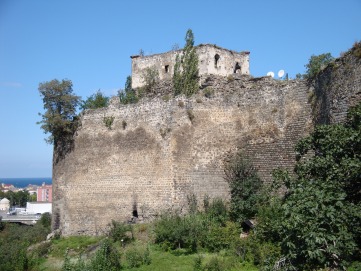 Last remnants of Byzantine palace on “trapezus”During the Byzantine period Trebizond was already doing well enough to boast several sizeable churches. However, the natural course of its history was abruptly altered in 1204 when the Fourth Crusade diverted from the Holy Land to grab İstanbul (then Constantinople). The Byzantine royal family was forced out of the city and one branch, headed by Alexios Komnenos, fled to Trebizond to set up a breakaway “kingdom” (a rival was established in Nicaea (modern İznik).
Last remnants of Byzantine palace on “trapezus”During the Byzantine period Trebizond was already doing well enough to boast several sizeable churches. However, the natural course of its history was abruptly altered in 1204 when the Fourth Crusade diverted from the Holy Land to grab İstanbul (then Constantinople). The Byzantine royal family was forced out of the city and one branch, headed by Alexios Komnenos, fled to Trebizond to set up a breakaway “kingdom” (a rival was established in Nicaea (modern İznik).
In 1261 the Crusaders were forced out of Constantinople but Trebizond continued to steer its own course. The court of the Komneni monarchs was one of those lucky ones that managed to benefit from other people’s misfortunes. As the Mongols rampaged through Central Anatolia in the 13th century, the lucrative Silk Road to China was forced to divert northwards and Trebizond was in the ideal position to benefit. The result was a so-called Golden Age in art and culture.
Then in 1461 Fatih Mehmet, fresh from conquering Constantinople and still not yet 30 years old, roared in to grab this last stronghold of Byzantium from King David Komnenos who was executed in Adrianople (Edirne) in 1463.
More recently, Trabzon was a town was close enough to the old Soviet borders to have been greatly affected by the changes of the 1990s. The result is a town with a unique atmosphere and the fingerprints of Russia, Georgia and Azerbaijan stamped all over it.
Don’t leave town without trying:
- hamsi, the anchovy that swarms in the Black Sea in winter
- a bowl of delectable muhlama, the Black Sea take on cheese fondue
- Laz boreği, a delicious dessert of layered pastry, confectioner’s custard and icing sugar rather like a cream slice
Around town
To get to Ortahisar stroll down pedestrianised Uzun Sokak (Long Street) which is just as jam-packed with shoppers as İstiklal Caddesi in İstanbul. Trabzon Museum On the way you’ll pass Trabzon Museum (closed Mondays) which is housed in an early 20th-century mansion that, while designed by an Italian, looks rather like a French chateau accidentally transferred to Turkey. This is a place to come to gawp at the opulent lifestyle of a Greek banker who must have been the 20th-century equivalent of the football-club-buying Russians who used to haunt 21st-centuryLondon. The contents are fairly run-of-the-mill with the exception of some fine woodwork on display upstairs and a giant but strangely flattened statue of Hermes in the basement.
Trabzon Museum On the way you’ll pass Trabzon Museum (closed Mondays) which is housed in an early 20th-century mansion that, while designed by an Italian, looks rather like a French chateau accidentally transferred to Turkey. This is a place to come to gawp at the opulent lifestyle of a Greek banker who must have been the 20th-century equivalent of the football-club-buying Russians who used to haunt 21st-centuryLondon. The contents are fairly run-of-the-mill with the exception of some fine woodwork on display upstairs and a giant but strangely flattened statue of Hermes in the basement.
At the end of Uzun Sokak is the Tabakhane (Tobacco Factory) Ravine which is filled with pretty small allotments. A bridge brings you to the “trapezus” that lay at the heart of the breakaway Byzantine Empire and its finest monument, the Fatih Cami, which was once the golden-domed church of Panagia Khrysokefalos. This was where Komnenian coronations took place.
If you take Kale Sokak, which heads inland from the mosque, you will come eventually to the slight remains of the old Komnenian palace, so unloved now that gecekondus (slum housing) are built right up against the walls.
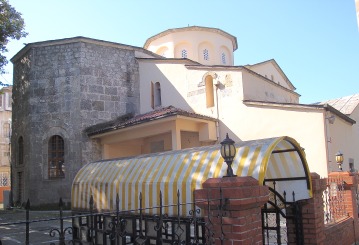 Church of Panagia Khrysokefalos, now Fatih CamiOn the far side of the “trapezus” is the Zağnos Ravine where the authorities have pulled down other gecekondus to create a landscaped park.
Church of Panagia Khrysokefalos, now Fatih CamiOn the far side of the “trapezus” is the Zağnos Ravine where the authorities have pulled down other gecekondus to create a landscaped park.
Here, too, is the fine early Ottoman Gülbahar Hatun Cami. Between 1490 and 1512 Sultan Selim the Grim served as governor of Trabzon, and he had this mosque and tomb built for his mother, herself once a Komnenian princess. His son, Sultan Süleyman the Magnificent, was born in Trabzon and statues of both sultans adorn the attractive park behind the Fatih Cami.
Afterwards, make sure to wander round the crowded bazaar streets branching off Kunduracılar Caddesi where branches of LC Waikiki, Beko and the Şekerbank are now housed in meticulously restored old buildings, once again echoing İstiklal Caddesi.
Near the huge Çarşı Cami (1839) you’ll find the restored 14th-century Genoese bedesten (covered market) and, if you’re lucky, the atmospheric Sekiz Direkli Hamamı (Eight-Pillared Hamam), open to women on Thursdays and men at all other times. It still retains the namesake rough-hewn columns which are said to date back to Selçuk times.
In Sept 2012 work had started on restoring the nearby Alacahan building too.
Just north of Atatürk Alanı in a narrow street cutting down to the sea is the Catholic Church of St Mary which dates back to 1854 when it was built by Italian Capuchin monks expelled from Russia by Czar Nicholas I; the current church is a rebuild dating from 1874. It still provides Sunday services for a small local congregation despite the murder of its last priest, Father Andrea Santoro, in 2006
Hagia Sophia/Ayasofya
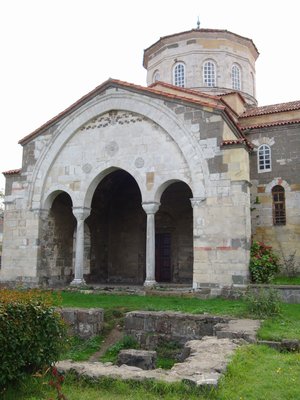
The most striking relic of the Komnenian Kingdom is the church of Hagia Sophia (Aya Sofya) that lies some way to the west of the “trapezus” on a headland overlooking the sea (now over the busy coast road). Built between 1238 and 1263, this wonderful building still retains many of its glorious 13th-century frescoes, a product of the so-called Golden Age of Trebizond. They were extensively restored in the 1960s and the church – which had been operating as a mosque – was turned into a museum in 1964. In 2013 it was turned back into a mosque again. After protracted legal argument arrangements have apparently been put in place to enable the frescoes in the prayer hall to be visible outside prayer times.
Look closely at the outside wall of the apse and you should be able to make out tiny drawings of sailing ships scratched into the walls by bored mariners. The grounds of the church also contain a fine collection of Ottoman tombstones.

A detached belltower dating from the 15th century overlooks a small tea garden adorned with a serander, a type of barn raised on stilts to keep rodents at bay that was popular all around the Black Sea; locals flock here to tuck into hearty brunches that incorporate bowls of muhlama, a Black Sea-style cheese fondue.
You get a particularly good view of Hagia Sophia and the detached belltower as you come into Trabzon from Giresun.
Into the suburbs

Far less visited than Haghia Sophia is the Kaymaklı Monastery, which lurks in the grounds of somebody’s farm way to the south of Boztepe, a popular picnic spot offering a panorama over the whole town. Kaymaklı is believed to date back to the 15th century, but what makes it so remarkable is the cycle of dramatic 17th-century frescoes on the walls of a small chapel saved from loss only because until recently they were hidden behind the farmer’s hay|
No trip to Trabzon would be complete without a visit to the lovely Atatürk Köşkü (closed Mondays), another early 20th-century mansion built for a banker, this time in whitewashed, wooden Crimean style.
Finally, the Kızlar Manastır (Girls Monastery, AKA Panagia Theoskepastos Manastır) dates back to the late 14th century but looks more like an abandoned barracks than a monastery. A high wall encloses a complex that includes several convent buildings erected in the 19th century and a rock-cut chapel with a fresco of Emperor Alexios III (r.1349-90) and his wife and mother. After restoration, the monastery is now open to the public again. The views from the approach steps are breath-taking.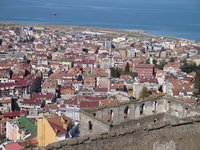
Eating and drinking
Trabzon is short of truly outstanding places to eat although there are plenty of pleasant small lokantas, many of them gathered around Atatürk Alanı.
İskenderpaşa Köfte, signposted just off the square, is a good place to try Akçaabat köfte.
The more prominent and flashier Çemilusta, right on the square, serves kuymak, AKA the Laz cheese fondue muhlama.
You’ll find quiet tea gardens in Fatih Parkı in a setting rather like a botanical garden just above the square where minibuses wait beneath a flyover.
Sleeping
Trabzon has a large number of hotels although very few that you would actually want to stay in. Prices for the best of them are on the high side, reflecting a captive market of would-be Sumela Monastery visitors. Most of the hotels are clustered around Atatürk Meydanı.
Nazar Hotel Newish hotel in still somewhat grungy Güzelhisar Caddesi. Tel: 0462-323 0081
Usta Park Hotel Long-standing favourite with tour groups. In handy location close to Atatürk Alanı. Tel: 0462-326 5700
Zorlu Grand Hotel Trabzon’s best centrally located hotel in a busy shopping street running off Atatürk Alanı. Tel: 0462-326 8400
Shopping
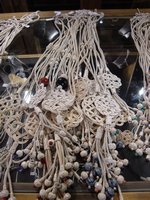 Trabzon is famous for its hasir bilezik, lovely torque-like bracelets that come in matt or polished silver, and for its kazaziye, silver necklaces that are effectively knitted. You’ll see fine examples of both on sale in the Gümüş Sarayı jewellery shop just in front of Hagia Sophia.
Trabzon is famous for its hasir bilezik, lovely torque-like bracelets that come in matt or polished silver, and for its kazaziye, silver necklaces that are effectively knitted. You’ll see fine examples of both on sale in the Gümüş Sarayı jewellery shop just in front of Hagia Sophia.
Transport info
There are daily flights from İstanbul and Ankara to Trabzon airport which is just past the large Forum Shopping Centre on the eastern side of town and easily accessible by public transport. Sit on the right-hand side of the plane to see the “trapezus” from the air as you come into land right beside the Black Sea.
Trabzon was one of the last bastions of the old-fashioned taxi-dolmuş. These have now given way to white vans that carry nine instead of four passengers and whiz around town in great numbers from a variety of different terminals, mainly around Atatürk Meydanı.
Minibuses to surrounding towns and villages leave from two gathering points on the waterfront, one to the east and one to the west depending on the direction of travel. The eastern gathering point in particular is a dismal spot – try to avoid having to spend much time there as there are not even pleasant cafes in which to wait. It’s only advantage is that it’s a mere 10-minute walk from Atatürk Meydan.
The otogar, to the east of town, is not a great deal cheerier although it’s easy to get to by dolmuş.
Day trip destinations
The Byzantine Golden Age in Trebizond The relics of a few small churches dotted about town prove that there were already Byzantines here before 1204, but from that date onwards the grand scale of their buildings played to the Komnenian government’s over-blown concept of its own importance. Take a good look at what is now the large Fatih Cami on the trapezus and you will be seeing was once the magnificent, golden-domed Byzantine cathedral, Panagia Khrysokefalos, where most of the tinpot Komnenian emperors staged their coronations. Of their once glorious palace only a few shattered remnants survive inland and up a hill, with gecekondus right up against the walls. But out west on a bluff overlooking the sea the church of Hagia Sophia (Ayasofya) is a remarkable reminder of the wealth that the breakaway Byzantines managed to accrue, especially as Mongol raiders ripped across Central Anatolia and forced the Silk Road traders to divert north through Trebizond. Built of stone and marble and richly adorned with frescoes as fine as those in the Chora Church in Constantinople, Hagia Sophia symbolises what is often referred to as the Golden Age of Trebizond. It’s a place where you can almost feel the Komnenians still breathing down your neck.
One or two of the Komnenian emperors opted to be crowned on the mountainside at Sumela rather than in the city.
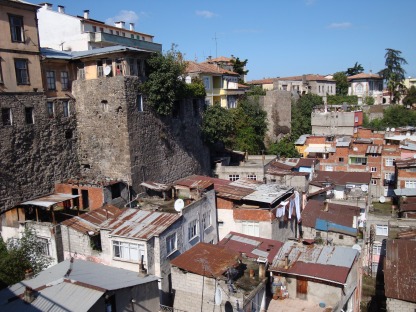 Ortahisar Mahallesi before urban regeneration project began…
Ortahisar Mahallesi before urban regeneration project began…
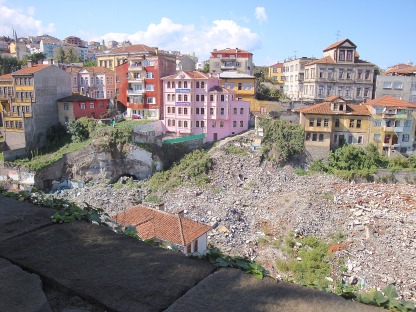 …and while it was in progress in 2012
…and while it was in progress in 2012


